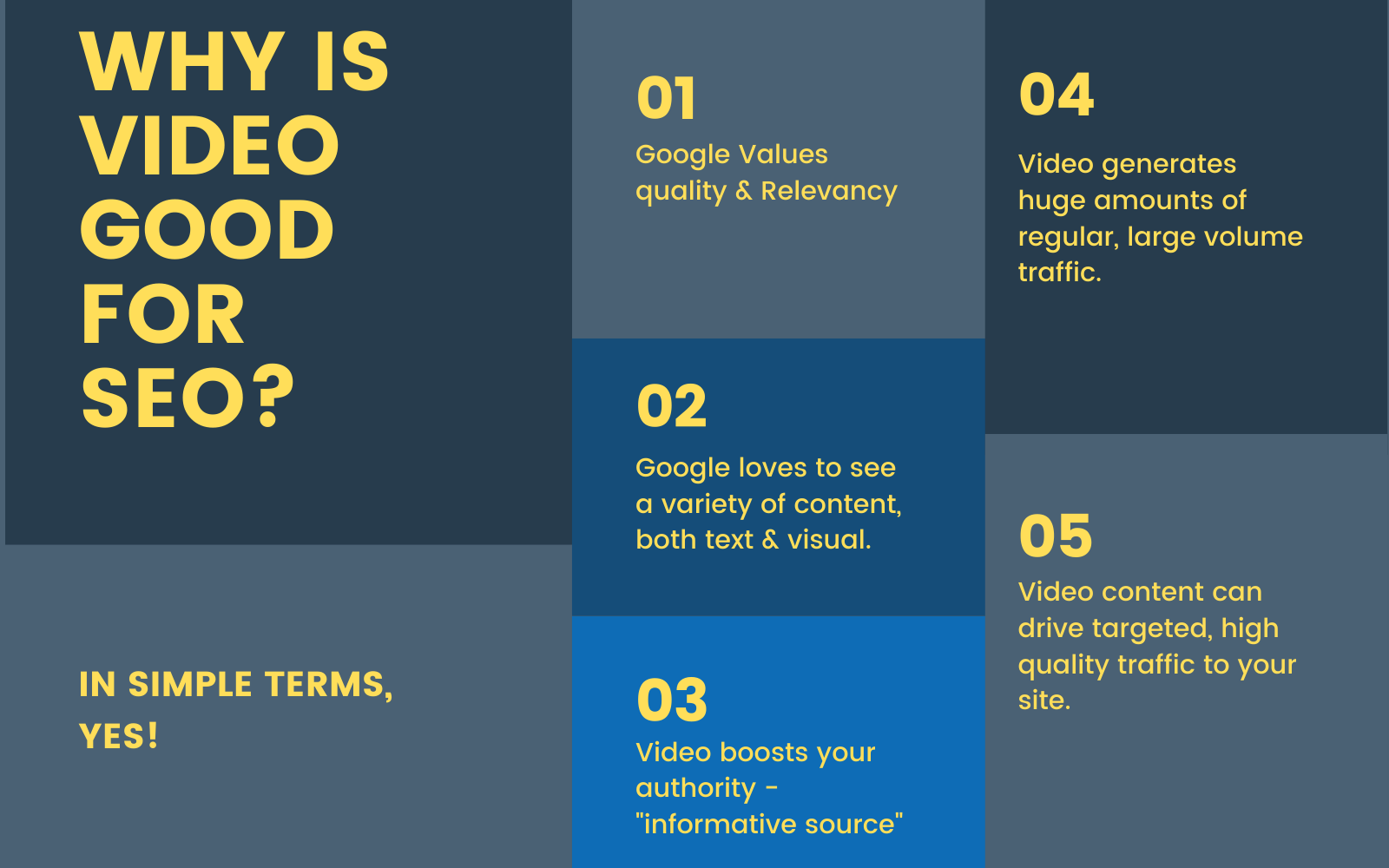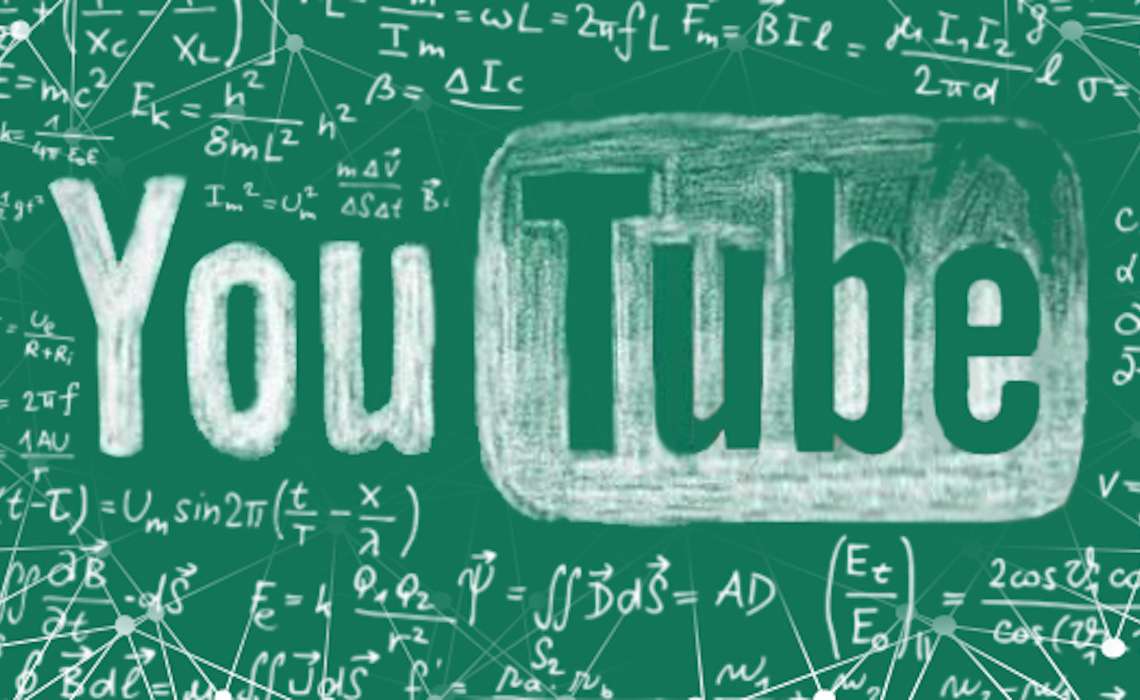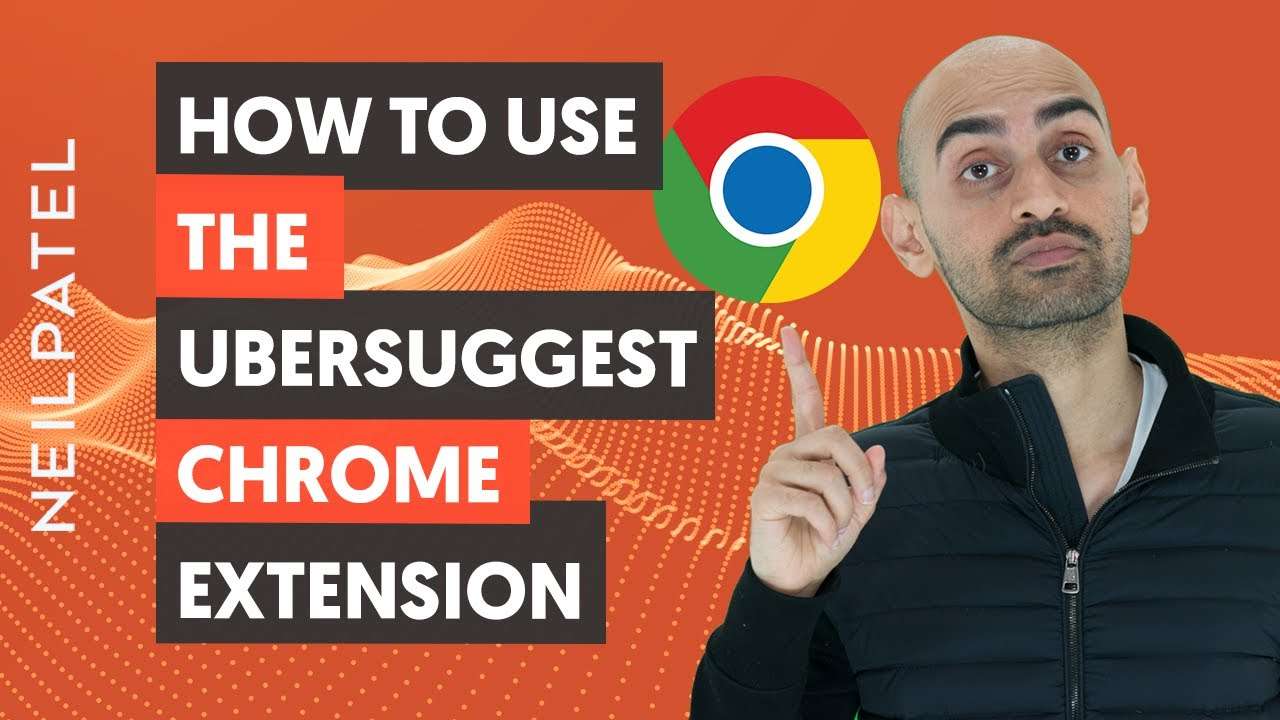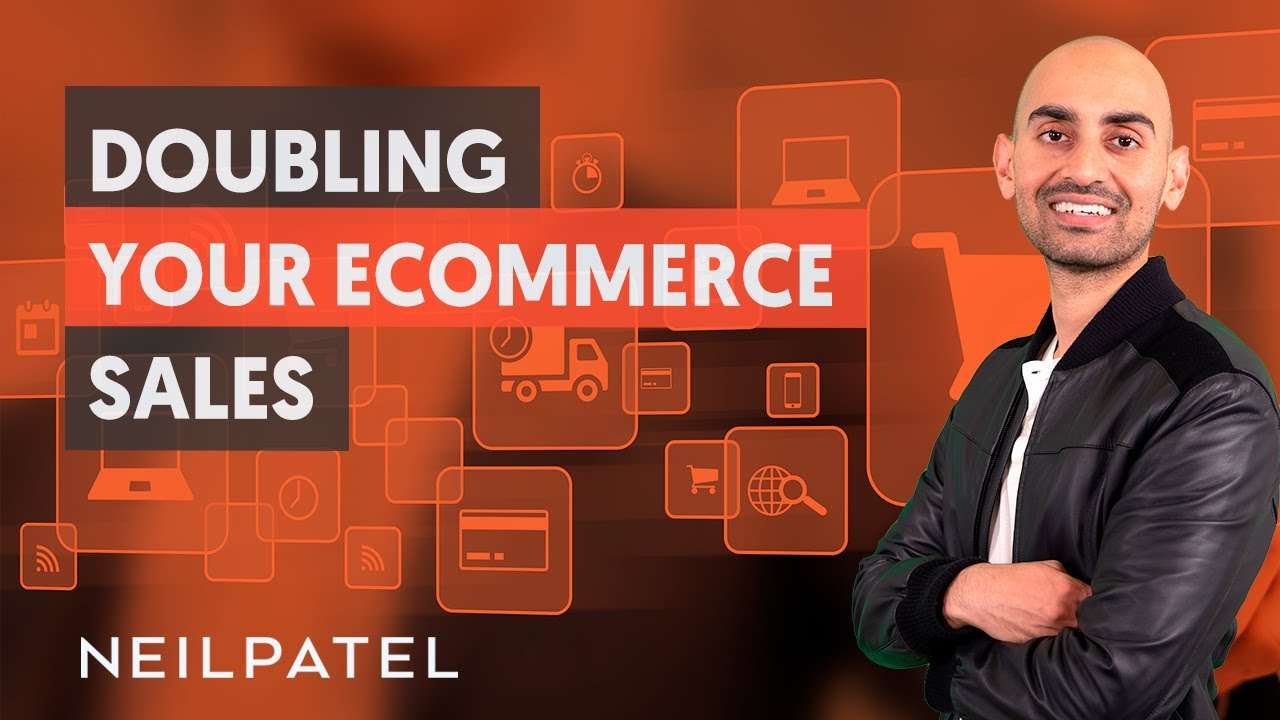Is Video Good for SEO?

Video SEO has dramatically changed in the last few years. Those YouTube tutorial videos from SEO experts from 2012 or even as recent as 2018 may as well be prehistoric. Simply put the game has changed and if you’re following these roadmaps you’re going to end up with disappointing results.
The YouTube algorithm is a tricky one, but generally speaking, it tries to match individual viewers to the content they are most likely to watch and enjoy – As you can imagine this is quite the challenge given the sheer volume of content being uploaded to the platform on a daily basis.
Simply put, Google truly values two things – The overall quality of your content and its relevance to a search term. In order to determine this, the search engine doesn’t just simply scan text on a certain page, it also crawls through dozens of different types of media to see what it exactly is you have to offer. If your site is providing a good mixture of text and also quality video, your page will be deemed informative AND varied, which will give a great boost to your overall SEO efforts.
Video also generates a huge amount of traffic – When Google determines the overall search rankings one of the things they really examine is the sheer amount of incoming traffic you have. If your domain has a large volume of regular, consistent visitors Google will assume they’re more than likely coming for a reason. Browsers are far more likely to visit your website after watching a video on YouTube than they are any other content.
The more video content you produce and create, generally speaking, the more quality traffic can bring to your page, which again over time will boost your overall SEO.

As we all know, the longer a user spends on your page the better. Google pays very close attention to how long a user is staying on your site once they finally land – If you’re generating a lot of traffic, but users are bouncing out after a few seconds it signals to Google that your content isn’t actually very good and users are heading somewhere else to get the answers they need.
This is where you can change tactics and make video good for SEO. An informative, engaging video will keep users on your page for longer periods of time. People are far more likely to watch a video than they are to read a 2500-word blog post, even if the key point of the two pieces is the same.
When you’re asked how is video good for SEO you can answer the question very easily. Yes, why? Backlinks.
Quality backlinks are one of the most important ranking factors, they carry a substantial amount of weight. The more people link to your domain and link to your content, the more authority you are deemed to have by Google. The more authority, the higher the rank.
By publishing your content on a site like YouTube you’re lining yourself up for the perfect opportunity to grab some quality traffic and earn some excellent referral traffic that will dramatically influence your overall ranking. Video content is also highly shareable across social media and although we don’t know for definite how the Google algorithm works, we do know there is a significant correlation between high volume shares across social media and higher search engine results.
So now that we’ve determined how is video good for SEO – How do we optimise our content for it? Well, you’ve got to understand the most popular platforms first.
It’s rather convoluted, but from what we do know the YouTube algorithm “follows the audience” by considering –
The overall top ranking factor for content on YouTube is currently ‘viewer satisfaction’. Back in 2011, the top ranking metric was clicks & views and in 2012 watched time. 2015 was when the current metric was introduced but as you can see, things tend to change quickly.

You may ask, how does YouTube measure say ‘viewer satisfaction’? Well, you might have noticed a survey pops up every once in a while when you’re watching a video asking how you feel about the content you just watched, this data is then used to accurately train prediction models in order to select, identify and highlight videos which are satisfying to the viewer. Engagement signals are also factored in, mainly likes & dislikes.
Now we have a good basis, how do we tackle the giant that is YouTube? Firstly, you’ve got to understand what goes into it.
The YouTube search function operates in a very similar way to the Google one. It attempts to present the most relevant results according to the keyword terms that are entered into the engine. The results are displayed depending on a number of factors including description, title and overall video content. In addition to this, YouTube also examines which videos have received the most watch time and general engagement for a certain query.
Thumbnails and titles are vitally important, they are often the very first thing a potential viewer will see when browsing YouTube – These two elements work in tandem and effectively operate as an advertisement for your clip but they must be an accurate representation, not clickbait.
If a user clicks into your video, watches the entire thing or most of it, this sends signals to YouTube that this user is enjoying your content, however, if your thumbnails and titles don’t accurately represent what is in your video, viewers will almost instantaneously click out and leave the content. This sends signals to YouTube that you are publishing potentially spammy or clickbait-like content, which in some cases can really limit your overall discoverability across the platform.
When it comes to optimising your titles, follow these tips
Thumbnails are a different business. They’re the first thing a viewer sees and you’re going to have to grab them. When customizing a thumbnail be sure that it’s vibrant and conveys key info regarding the video, apply the “rule of thirds” when composing your thumbnail. Keep it as high a resolution as possible within the 2MB limit, 1280×720 pixels and see how your design weighs up against the competition.


The suggested videos are just a personalised collection of videos specific to a user, compiled based off of prior activity data. These videos are shown to viewers on the right-hand side of the page, just below the ‘watch next’ section.
Studies recently released by YouTube have shown that viewers gravitate toward watching more content when they spot recommendations from a few different channels, so this is what the Suggested Videos tab provides. These recommendations are ranked in such a way as to totally maximise engagement for the viewer.
If you want to really optimise your content for the Suggested Videos, you need to hone in on making a strong call to action that will encourage a viewer to watch another edition of your series. Avoid drawn-out, long endings as it may discourage a viewer from watching more, try to keep it snappy and utilise links, cards and end screens to suggest the next ideal video.
200 million different videos appear on the homepage for viewers across the globe. This is also one of the best places for your videos to be found by non-subscribers.
When a user visits their Home, YouTube throws up videos from their subscription feeds, videos watched by similar users and also new videos. This selection is compiled using a number of factors, one of which being overall video performance, how it has engaged viewers and more importantly how it has satisfied them. A user’s watch and search history are also important here.
You can actually check to see how often your channel appears on the YouTube Home page in your YouTube Analytics Traffic Sources Report. Hit the Browse Features tab and check out the Home stats. If you’re aiming to hit the home page, keep your uploads consistent, and give your audience a loose schedule so they will know when to expect new videos. Attempt to keep them engaged for a longer period of time, this will make your channel far more likely to be spotlighted on the Home.
This is a tricky one – Likes and dislikes do impact how your video appears in users’ feeds, kind of.
Obviously, they are ranking signals, the algorithm uses these likes and dislikes to see how much of a video a user watches and perhaps more importantly if they are satisfied with the content. A huge number of YouTubers always ask their viewers to “like, share and subscribe” during their videos, that’s because they’re all ranking signals, engagement, its satisfaction. These, alongside comments, are vitally important.

These are a great way to ramp up engagement as they prompt the viewer to take an action. You can use them to suggest another video on your channel or just promote your overall brand. Generally speaking, video cards work the best when they link directly with the video, say for example someone in a video is speaking about a topic they touched upon in a previous release, they might use a card to highlight that video when referring to it, which would encourage a user to then go watch that clip.
Cards should be used to –
In comparison, end cards can be used to –
Now we know how YouTube works and the basics of creating good content, you can begin to optimise for SEO purposes. First things first, you’ll need the right keyword. Your keyword should appear in your video title, metadata, spoken audio, captions and transcripts. That’s the ideal mix for SEO. It’s also vital that the content of your video and your keyword correspond, your keyword should accurately describe your video.
Keyword research is essential, but luckily YouTube does a lot of the work for you. To find what keywords & phrases people use in search you can just punch in a phrase or word relevant to your industry into the search bar and see what suggestions YouTube offers up.
It’s important to include your keyword in your videos file name so YouTube can immediately identify the topic of your video, for example, if my chosen keyphrase was SEO Cork I would name my file “Tips-To-Boost-SEO-Cork-With-Video”

We’ve all seen it, YouTube automatically transcribes your video in order to provide automatic captions however these are usually comically bad.
Google actively penalises spam and rewards helpful search results, so it’s no surprise then that automatically generated captions are deemed as spam and therefore will negatively affect your SEO efforts. You can add accurately captions to your videos through an SRT file.
Google bots can’t watch videos, but they can crawl text. Your captions will be absolutely packed full of your chosen keyword, which indicates to Google what your video is about and therefore ranks it accordingly.
You may be thinking “oh god, I don’t have the time to caption my own videos” and you’re not the only one. Thankfully there are some solutions, you can use the automatically generated captions as a starting point and tidy up mistakes or alternatively, hire a freelancer on a site like Upwork or Fiverr to transcribe for you.
Captions are essential for boosting user experience and engagement. Closed captions actively increase your viewership as they circumvent a potentially huge barrier to viewership, audio. You don’t need audio if your video is captioned, which is especially relevant to mobile users who make up at least 70% of YouTube watch time.
– We know it is, but the real trick now is to optimise your content effectively in order to see the best results. Be sure to follow the steps above and keep on top of your analytics, regularly monitor where your videos are doing well and where they may need some tweaking. Once you get the balance right, you’ll see the difference.
If you’re looking for more useful SEO guides, tips & tricks, check out our guide on How to Master SEO Content Creation – Long form reads and also our Expert commentary on The Importance of Reviews for SEO.
As an SEO agency, we can help get your website onto Google’s first page. Would you like a higher click-through rate to your site? Are you continually seeking leads? At our agency, we provide the following SEO services.
Contact us today at [email protected] or by calling 021-201-1993. We will help you get found online.
If you liked this blog, then you are in luck because we have plenty of SEO and digital marketing-related blogs. We have blogs on topics like how to write meta descriptions, integrate email and SMS marketing, how to master SEO content creation and common technical SEO issues. Or for more check out our blog section.
Copywriting 2022 Digital Funnel Ltd.